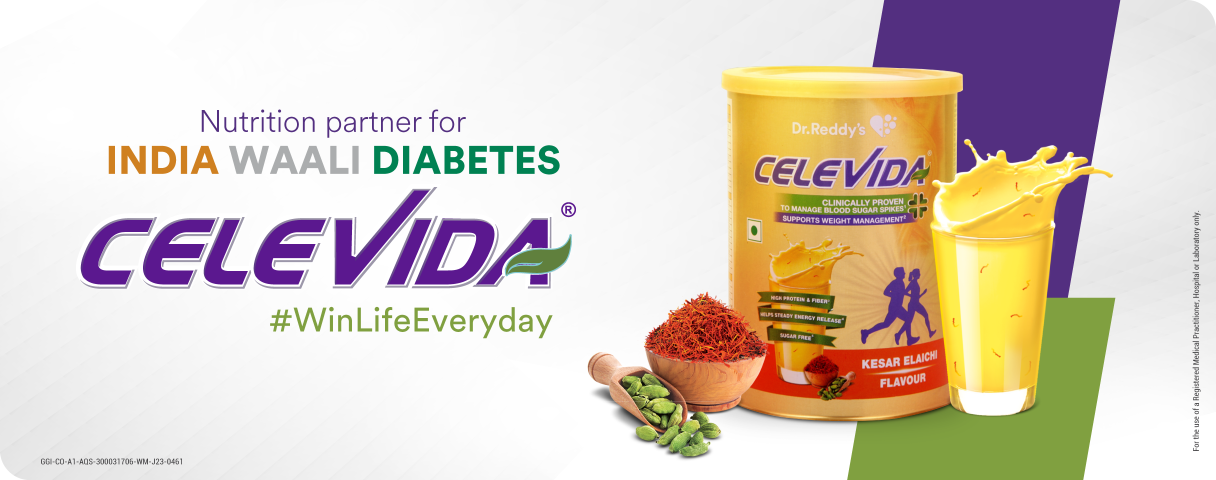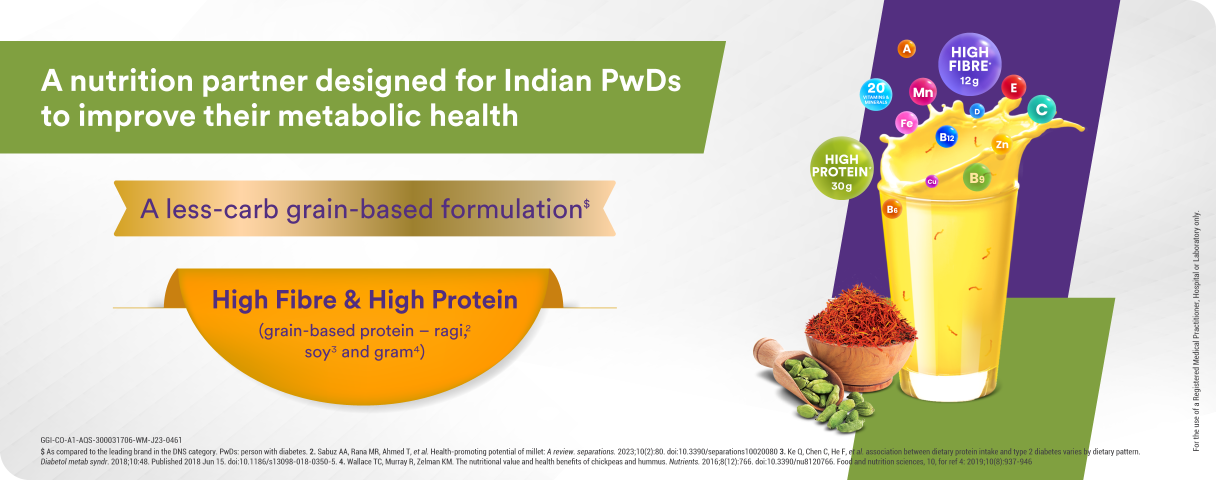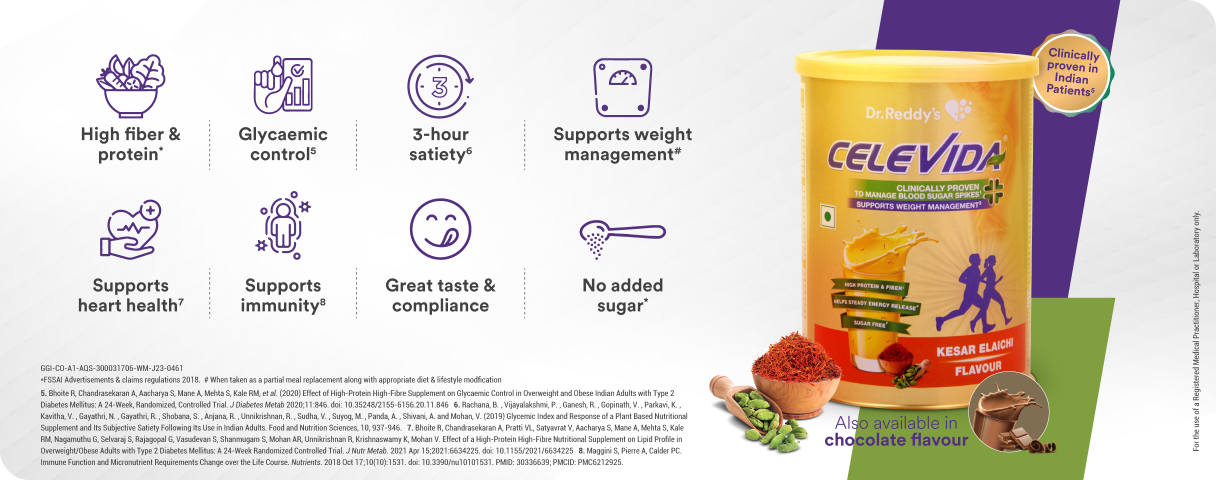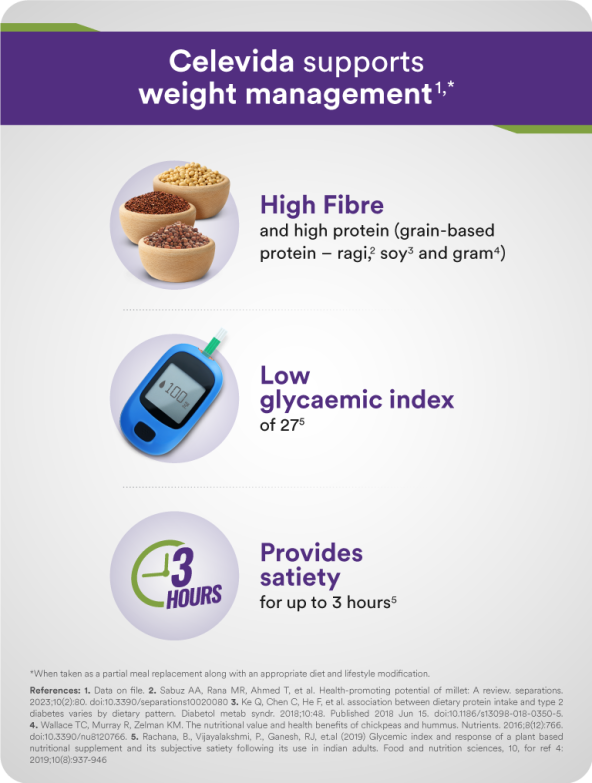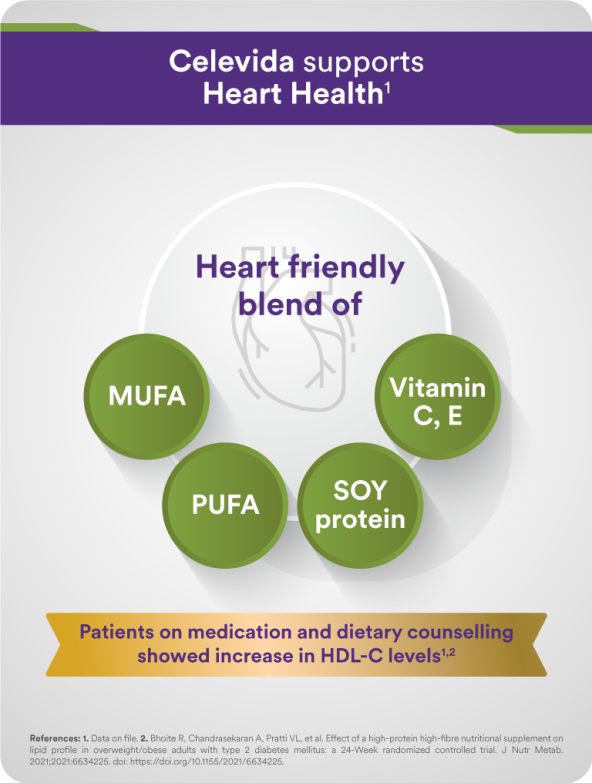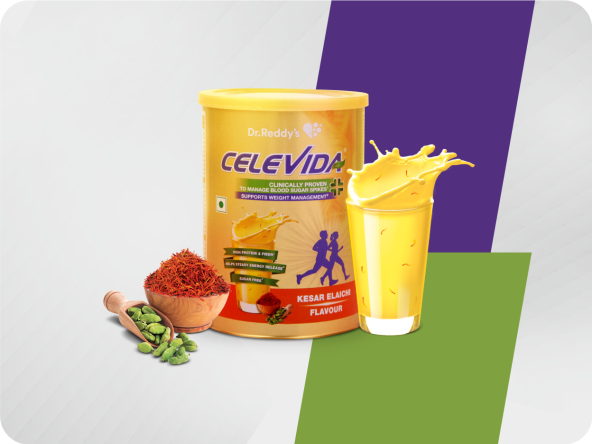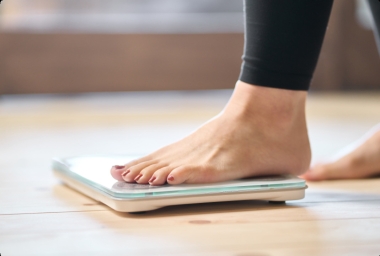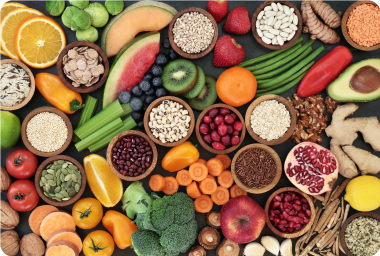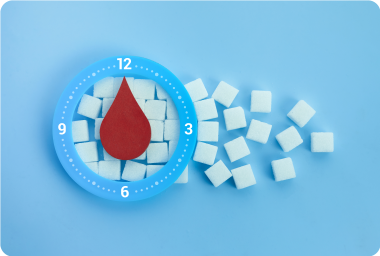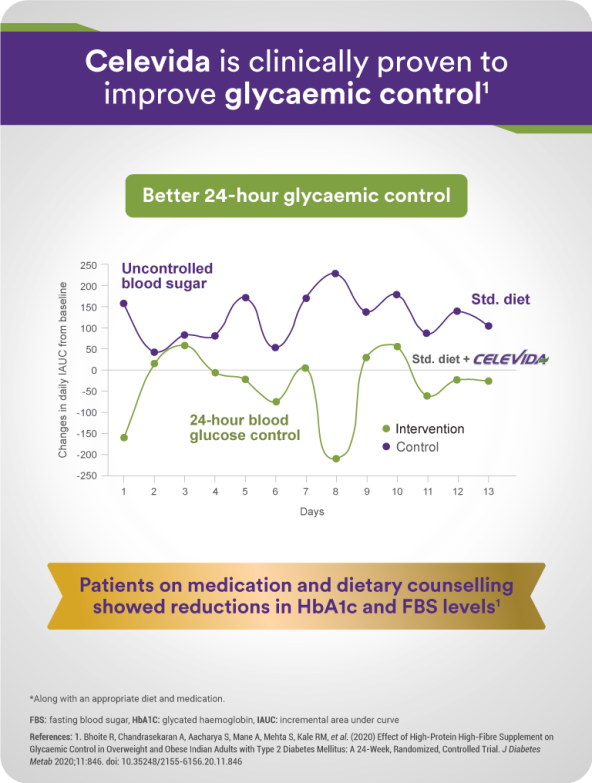
Why Celevida?
Dr. Reddy’s Celevida is a scientifically formulated nutrition drink designed for people with diabetes and pre-diabetes, which is clinically proven to control 24-hour blood sugar spikes, support heart health and help with weight management. Celevida contains a high protein level between 28-30g per 100g depending on the flavour, high fibre levels (12 to 18g per 100g) and slowly digested carbohydrates, which will support in managing the postprandial blood glucose and satiety.
-
Celevida is currently available in two flavours, Kesar Elaichi and Chocolate.
-
Celevida is formulated with Soy, Ragi, Milk Protein and Gram Flour, which is considered a complete protein as it has all the amino acids and other macro-nutrients. Celevida contains ingredients that you know and can trust.
-
Celevida is a Nutrition Drink designed for Indians and is specifically catered to an Indian Diet, which is high in Carbohydrates. Celevida provides only 27% carbs in the Kesar Elaichi flavour.
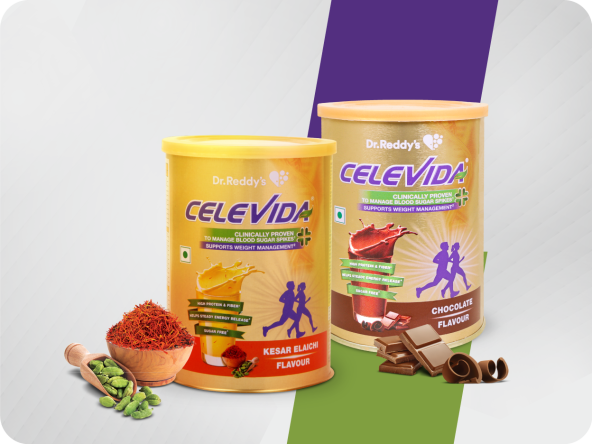
How to Use?
Add 1 heapful scoop (25g) of Celevida Kesar Elaichi/Chocolate flavour in 200 ml of water or milk. Stir well to mix and consume within 30 minutes.
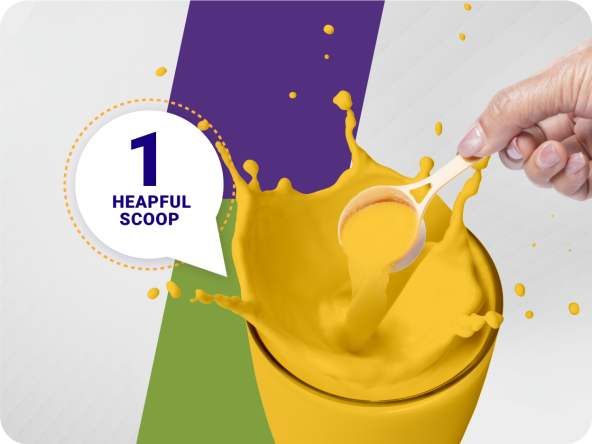
Experts' Talk
Patient Education Videos
Knowledge Hub
FAQs
1. For whom is Celevida designed?
Celevida is a scientifically designed formula for diabetic subjects which can be added to their diet plan along with regular exercise.
2. Will using Celevida increase blood sugar levels?
Celevida is scientifically designed to help minimise blood sugar spikes. Celevida provides energy from fat, protein, and carbohydrates. Carbohydrates, compared to fat and protein, have the biggest impact on blood glucose levels. The carbohydrates in Celevida were chosen for their low glycemic index, which helps minimise blood sugar spikes compared to high-glycemic carbohydrates.
3. Is Celevida a medicine for blood sugar control?
Celevida is not a medicine for blood sugar control. Celevida is diabetes-specific nutrition designed to help blunt the postmeal blood sugar response. Celevida is designed to meet the nutritional requirements of people with diabetes.
4. What are low-glycemic carbohydrates?
The glycemic index measures how foods with carbohydrates raise blood glucose. Low-glycemic carbohydrates produce lower blood glucose responses than high-glycemic carbohydrates. Celevida is formulated to help minimise blood sugar spikes and contains unique blends of carbohydrates that include: modified maltodextrin (the body is not able to digest it), soy fibre, and fructooligosaccharides (a prebiotic fibre).
5. When is the best time to use Celevida?
Use Celevida anytime to substitute meals or parts of meals, or as snacks. Use Celevida as a quick breakfast supplement or bring it to work for convenient snacks or lunches. Celevida may also be used as night time snacks. Celevida may be used as a protein source before or after exercising. Please consult your doctor for more information.
6. Can Celevida be used as part of a person’s current diabetes meal plan?
Celevida should be incorporated into a person’s diabetes meal plan and overall management plan. Studies support the use of Celevida in conjunction with a diabetes management plan.
7. Is Celevida appropriate for me if I have type 1 diabetes?
Celevida is appropriate for people with type 1 diabetes. It is important to monitor blood glucose regularly to see how Celevida affect insulin needs. Celevida contain blends of carbohydrates that are low-glycemic to help minimise peaks in blood sugar. We encourage patients to discuss any changes with their health care professionals and any specific weight loss goals.
8. Is Celevida a good choice for low blood sugar (hypoglycemia)?
For people with or without diabetes, Celevida should not be used to treat hypoglycemia, insulin shock, or insulin reaction because the carbohydrates from Celevida do not elicit a large blood glucose response and would not help restore blood sugar. Talk to a health care professional about appropriate treatment options for low blood sugar (hypoglycemia).
9. Can Celevida be used by people with prediabetes?
Yes, Celevida has been designed to help minimise blood sugar response and can help manage weight when used as part of a diabetes management plan. Managing blood sugar response and weight are important for people with prediabetes. A health care professional has the primary responsibility to select the product most appropriate for a patient based on medical assessment.
10. What is the type of Carbohydrate in Celevida?
Celevida contains unique blends of carbohydrates that include: Fibersol, a resistant maltodextrin (the body is not able to digest it), soy fibre , and fructooligosaccharides (a prebiotic fibre).
11. What is the type of protein in Celevida?
Celevida has a mixture of milk protein and plant protein like soy and Bengal gram.
12. What is the quality of protein in Celevida?
The difference lies in the building blocks of proteins—the amino acids. There are 20 different amino acids, 9 of which are essential, meaning they must be provided by the foods in our diet. The other 11 amino acids are called non-essential because they are made by the body. Foods containing all of the 9 essential amino acids are called complete proteins. Celevida provides all the essential amino acids and thus provides good quality protein.
13. Why is Celevida good for heart health?
The fat blend in Celevida was developed with the goal of facilitating metabolic control in patients with diabetes, specifically, improved glycemic and lipidemic profiles. High Monounsaturated Fatty Acids (MUFA) diets may help reduce blood cholesterol, blood pressure and other heart disease risk factors, particularly if they replace some saturated fats in the diet. Celevida contains a good proportion of MUFA and thus is heart healthy.
14. What is the source of MUFA in your product?
High-oleic sunflower oil used in the product is the source of MUFA in the product.
15. How do you claim that your product is high protein?
As per the Food Safety and Standards Authority of India (FSSAI) regulations, Nutrition and Health Claims [1], for a claim of high protein, the product must contain 20% of the recommended dietary allowance (RDA) of protein per 100g. The RDA for protein is 60g. Accordingly, the product should contain minimum 12g of protein per 100g. The health food drink (HFD) provides 28-30g of protein per 100g and therefore qualifies for high protein claim.
16. How do you claim high fibre in your product?
As per the Food Safety and Standards Authority of India (FSSAI) regulations [1] and CODEX Nutrition and Health Claims [28], for a claim of high fibre, the product must contain 6g per 100g or 20% of the recommended dietary allowance (RDA) of fibre per 100g. The RDA for fibre is 30g. Accordingly, the product should contain minimum 6g of fibre per 100g. The health food drink (HFD) provides 12-18g of fibre per 100g and therefore qualifies for a high fibre claim.
17. Is high protein advisable for diabetics suffering from renal problem?
This product is not designed for subjects suffering from renal problems as a co-morbidity of diabetes.
18. What is GI?
The Glycemic Index (GI) is a relative ranking of carbohydrates in foods according to how they affect blood glucose levels.
19. What is Sucralose?
Sucralose is an artificial sweetener and sugar substitute. The majority of ingested sucralose is not broken down by the body, so it is noncaloric. Sucralose is about 320 to 1,000 times sweeter than sucrose. Sucralose has been accepted as safe by several national and international food safety regulatory bodies, including the FDA, the Joint FAO/WHO Expert Committee Report on Food Additives, the European Union's Scientific Committee on Food, Health Protection Branch of Health and Welfare Canada, and Food Standards Australia New Zealand. According to the Canadian Diabetes Association, the amount of sucralose that can be consumed over a person's lifetime without any adverse effects is 900 mg per kg of body weight per day.
20. Is sucralose synthetic?
Yes, Sucralose is a synthetic product. Sucralose is manufactured by the selective chlorination of sucrose in a multistep synthesis, which substitutes three of the hydroxyl groups of sucrose with chlorine atoms.
21. Could it be given to pre-diabetic?
Yes, it can be given to pre-diabetic subjects.
22. Could Celevida be given with milk?
Yes, Celevida can be given.
23. Could it be added to any other food product?
Yes, it can be added to any food product based on individual taste.
24. Could it be given as an enteral/parental feed?
No. This product cannot be given.
25. How do you claim that your product supports weight management?
Fibre rich diet stimulates important colon mechanisms to increase levels of satiation (the process that terminates eating) and satiety (the process that inhibits further eating after a meal has been finished) to help promote energy balance and weight stability (along with physical activity) [16]. Lower energy-dense fibre-rich diets, as a replacement for higher energy-dense diets, help to promote energy balance to prevent weight gain [17]. This is because: (1) fibre is generally considered to be 2 kcal/g or less as compared to 4 kcal/g for digestible carbohydrates such as sugar and starch because fibre is not digested in the small bowel and (2) lower energy dense fibre-rich foods displace higher density foods [17-20]. Fibre-rich meals are more mouth-filling and harder to swallow because of their higher bulk, physical density, volume, or viscosity compared with energy-matched, low-fibre meals, and more rapidly reduce hunger after ingestion [17, 21]. Fibre-rich foods or clinically proven fibre supplements, especially bulky, viscous soluble fibres, increase intraluminal concentration or viscosity, slow gastric emptying, and create a mechanical barrier to the enzymatic digestion of macronutrients such as starch in the small intestine. Celevida also provides only 85 kcal per serve.
26. Can Celevida be used as a complete meal replacement?
When 3 scoops of Celevida of 25g each are added to a serving, it can be consumed as a meal replacement.
27. What are the side effects of consuming Celevida?
Celevida is clinically studied product. No serious adverse side effects have been seen for Celevida. Some patients may face GI disturbances like nausea and diarrhoea when consumed during the 1st time which is common with all protein supplements.
28. Can your product be consumed by children?
No, this product is not recommended for children as it contains artificial sweetener, which is not allowed for children.
29. Is sugar added to your product?
No, sugar is not allowed.
30. Are adjustments to insulin or oral agents necessary when starting Celevida ?
Celevida is designed to minimise after-meal peaks in blood sugar. When starting with Celevida, the dose or timing of insulin may need to be adjusted, and this adjustment must be individualised, under the supervision of a health care professional. People with diabetes should carefully monitor their blood glucose before and two hours after consuming Celevida to determine how their blood glucose is affected. Once they determine this effect, the dose and timing of injections can be adjusted as necessary. Consult a health care professional for guidance. Products should be used under medical supervision as part of a diabetes management plan.
31. Can Celevida be used during pregnancy for women with gestational diabetes?
It is safe for pregnant and lactating women but should be taken under medical advice.
32. Does Celevida contain gluten or lactose?
Celevida is not made with gluten-containing ingredients but may be made on the same manufacturing lines that have gluten-containing ingredients. Celevida does contain milk ingredients, which may contribute a small amount of lactose. It is not lactose-free.
33. Can Celevida be used by people without diabetes?
People without diabetes can safely consume Celevida. Celevida is specifically designed for people with diabetes or people trying to manage their blood sugar.
34. What are the ingredients in Celevida?
A variety of ingredients are used in Celevida to support one’s nutritional needs. These nutrients are all safe for humans and have been used in various other foods. For example, skimmed milk powder, defatted soy flour, gram flour, high-oleic sunflower oil, Fructose-oligosaccharide and soy oil. Please check the Ingredients section on the label for the complete list.
35. What are the benefits of adding fibre to the product?
Fibre helps in reducing the glycemic index of food products. It induces the feeling of fullness and help in the management of weight.
36. Can Celevida be mixed with other food products?
Yes, Celevida is in powder format. This powder comes in 2 flavours: Chocolate and Kesar Elachi. Based on a person’s taste/liking, powder can be added to other food products.
37. Why is the Glycemic Index (GI) of chocolate flavour high as compared to Kesar Elachi flavour?
GI is a very accurate method of assessing the amount of carbohydrates being absorbed in the blood. This means that even a slight change in the formulation will be reflected by the change in the GI. The chocolate flavour has cocoa powder and chocolate as flavouring agent. Because of these ingredients, the GI of chocolate is slightly higher. But the GI for both flavours is low and not significantly different.
38. Why is the GI of powder low when consumed with milk vs. water?
Milk contains some amount of protein and fat. Protein and fat are known to slow down the absorption of carbohydrates in the body and therefore lowers the GI of the product when consumed with milk.
39. What is Glycemic response?
Glycemic response is the term used to describe glycemic index of foods containing more than one source of carbohydrates (eg., breakfast cereal with milk, beverage mix with milk).
40. What are the limitations?
Children under 18 years should not consume Celevida. Anyone who has protein restrictions should not consume it. People with soy or milk allergy should not consume Celevida.
41. What are the contraindications?
Celevida is not suitable in conditions with low protein intake recommendations and for hypoglycaemic patients.
42. Can it be used by non-diabetic overweight/obese individuals to reduce weight?
Yes, Celevida is designed for diabetic and pre-diabetic subjects. Even people who want to manage their weight can consume Celevida, as it provides good satiety in only 85 kcal per serve. It’s high in protein and fibre which will be beneficial to overweight/obese subjects.
43. What is the duration of use?
Celevida is designed as a normal food supplement which can be used lifelong as part of healthy lifestyle management. The clinical study has shown that for maximum benefits, it should be taken for at least 6 months.
44. How many days will it take to see the results?
Celevida is clinically proven to reduce postprandial spikes of each meal, it works from day 1. To get evident results, Celevida can be consumed regularly for 3 months to see the impact on HbA1c. The results will be evident if a healthy eating pattern and physical activity have been followed.
45. How many calories we get when Celevida is mixed with milk?
210 kcal per serve (85 kcal from Celevida and 125 kcal from 200 ml of milk).
46. Can Celevida be given to Thyroid patients?
Most of the studies have shown that consumption of soy bean in moderation is beneficial and that soy supplementation has no effect on the thyroid hormones. Thus, Celevida can be recommended to a diabetic subject with a thyroid complaint.
47. Is soy good for men’s health?
Concerns have been raised about the effect of soy consumption on men’s health however, the clinical evidence indicates that there is essentially no basis for concern that soy may affect reproductive health. Hence, Celevida can be recommended for men with diabetes and for weight management.
48. What is the sodium content in Celevida?
1 serve gives 57 mg of sodium.
GGI-CO-A1-AQS-300031706-WM-J23-0461



